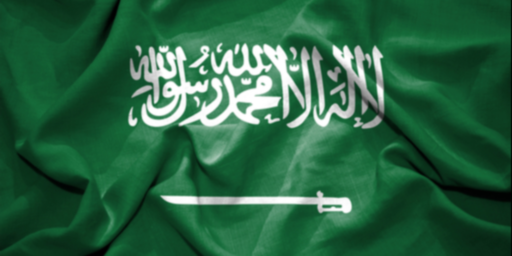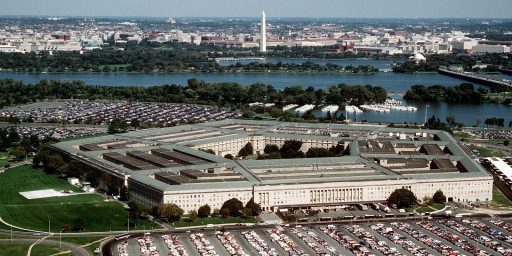David Kay, 1940-2022
A man made famous for discovering Iraq's WMD program was virtually nonexistent is gone at 82.

Washington Post (“David Kay, weapons inspector who helped disprove Iraqi WMDs, dies at 82“):
David A. Kay, the weapons proliferation expert who led a CIA-run operation in 2003 that concluded former Iraqi ruler Saddam Hussein had built no weapons of mass destruction, sharply undermining the chief justification for the U.S.-led invasion earlier that year, died Aug. 13 at his home in Ocean View, Del. He was 82.
The cause was cancer, said his wife, Anita Kay.
Dr. Kay, a reserved Texan with an international affairs doctorate, had an early career teaching political science before joining organizations such as UNESCO in Paris and the International Atomic Energy Agency in Vienna. In 1991, he became a household name while serving in Iraq as chief nuclear weapons inspector for the United Nations and the IAEA after the United States and its allies had liberated Kuwait from Hussein’s forces.
The mission of all the U.N. teams was to search out and destroy any banned nuclear, biological or chemical weapons or materials. In September 1991, using powers granted under a U.N. resolution, Dr. Kay’s nuclear team launched an unannounced inspection of a military facility in Baghdad to look for incriminating documents about Hussein’s clandestine efforts to develop nuclear arms.
Because it was close to his team’s hotel, Dr. Kay had already surveilled the building by running past it on his morning jog to see where security was tightest. During the inspection, his 44-member group was detained after attempting to remove documents and videotapes they considered significant, and endured a four-day standoff followed by media around the world.
Using a relatively newfangled satellite phone, Dr. Kay answered calls from news agencies, notably CNN, while surrounded by Iraqi guards. He and his team slept in their vehicles — a bus and several cars. As pressure from the U.N. Security Council and the world grew, the Iraqis let them leave with the documents and tapes.
“The chemical program was huge,” he later told journalists with the PBS series “Frontline,” summing up all the U.N. teams’ findings after the 1991 war. “The actual storage area of their main chemical weapons dump was larger than the District of Columbia. … In the nuke area, whereas before the war there were two facilities identified … instead we discovered 25 main sites that we had had no knowledge of, and that they, at that point, were probably six to 18 months away from having their first working nuclear device. It wouldn’t have been a pretty device, and it wouldn’t have launched on a missile, but it would have been a working device, and then rolling progressively forward on that area.
“Finally, when the biological program was fully exposed in the mid-90s,” he added, “we discovered that not a single site that had been hit in the air campaign of the first Gulf War had actually had an active biological program. They had moved them all to sites that we did not know about, successfully hid them. In fact, they had a very large anthrax program, botulinum toxin program, ricin, and a quite accomplished biological program.”
The U.N. teams destroyed Iraq’s illicit weapons and programs in the 1990s, but after the inspectors were forced out in 1998, the CIA worried Hussein was secretly rebuilding his WMD. After the al-Qaeda terrorist attacks on Sept. 11, 2001, the Bush White House portrayed those suspicions as irrefutable evidence of a direct Iraqi threat to the United States and its allies.
When the March 2003 invasion quickly toppled Hussein’s regime, a Pentagon team fanned out across Iraq but failed to find any sign of the weapons of mass destruction. That summer, President George W. Bush put the CIA in charge of the hunt, and CIA Director George J. Tenet picked Dr. Kay to lead the newly named Iraq Survey Group.
Although he went to Iraq convinced that sites suspected of housing weapons of mass destruction would be found, he soon concluded that none existed and that the CIA and other intelligence agencies had badly misjudged the available evidence. Frustrated by the CIA’s refusal to agree, Dr. Kay resigned from the weapons-hunting group in January 2004. Days later, he gave explosive testimony to the Senate Armed Services Committee.
“We were almost all wrong, and I certainly include myself here,” he told the panel. “It turns out we were all wrong, probably in my judgment, and that is most disturbing.”
Despite the Iraq War playing such a heavy part of the early years of the blog, I mentioned Kay precisely half a dozen times, all between 2003 and 2005. That he’s gone 17 years later, aged 82, isn’t all that remarkable.
Still, he seems like a man of a different time. A quiet professional who simply did his job and, in so doing, found facts that were embarrassing to the sitting administration, undermining a major tenet of its justification for a controversial war. And yet, so far as I can remember, no aspersions were cast. It was just assumed that Kay did his best and offered his honest assessment of the situation. We simply took the facts as they were presented, offering competing spins on them, without anyone impugning Kay’s competence, character, or patriotism.





It was a different time. On the other hand, we had Valarie Plame. So not so different after all.
@OzarkHillbilly: I always saw the Plame disclosure as essentially an accident. The administration was frustrated with her husband, Joe Wilson, and with the CIA and Richard Armitage and Scooter Libby were trying to discredit him by saying that he was being fed bad info by his wife, a CIA agent. There was no intent to burn her—I don’t think they even understood that she was undercover—so much as collateral damage.
@James Joyner: Just collateral damage in their effort to discredit factual information that showed they’d lied to justify invading Iraq. An invasion now recognized as the complete disaster a few pundits and the DFHs had said it would be. I’m not sure that’s much of a defense.
W. Bush still seems to be regarded as a good guy, well meaning even if wrong, who “protected the country”, even though there is now a consensus the invasion and occupation was a huge mistake. (Insert Picard facepalm graphic.)
@James Joyner: You are far too willing to give benefits of a doubt. First off, if they knew she was CIA, they had every reason and were very capable knowing what she did and who with. There was no intent to burn her? At best, they didn’t care. From everything I’ve read, burning her was just what they did to people who got in the way of their splendid little war.
@James Joyner: “There was no intent to burn her—I don’t think they even understood that she was undercover—so much as collateral damage.”
If they had no intent, they acted strangely.